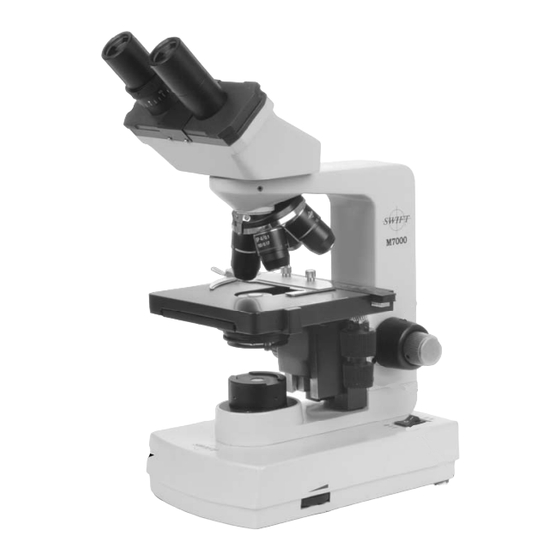
Table of Contents
Advertisement
Quick Links
Advertisement
Table of Contents

Summary of Contents for Swift M7000 SERIES
- Page 2 SWIFT M7000 SERIES The Swift M7000 Series offers tremendous value and quality. The smaller footprint accommodates small spaces, yet, it has all the standard research microscope features. This series is ideal for advanced high school biology, college or vet/medical applications. Combining rugged...
- Page 3 PICTURED M7000C...
-
Page 4: Components Of The Microscope
COMPONENTS OF THE MICROSCOPE ARM – the vertical column (attached to the base) which supports the stage and contains the coarse and fine adjusting knobs and focus mechanism. BASE – the housing and platform of the instrument to which the arm is attached. - Page 5 STAGE – the table of the microscope where the slide is placed for viewing. This component moves upward and downward when the focusing knobs are turned. The stage of the Swift M7000 has a built-in mechanical stage with a sub-stage “X” and “Y” axis controls. A finger clip holds the slide securely and is designed to be a slow return holder to provide protection to the specimen.
- Page 6 PARFOCAL – a term applied to objectives and eyepieces when practically no change in focus is needed when changing objectives. The objectives on your Swift M7000 microscope are parfocalized at the factory so that only a slight adjustment of the fine focus knob is needed to maintain...
- Page 7 ¼ inch (5 mm) open. If you have a Swift M7000 with a monocular head please omit steps 4 - 5. 4. For a binocular head, which has two eyepieces, the next step is to adjust the interpupillary distance (I.D.) and diopter adjustment ring...
- Page 8 eyes, then carefully and slowly slide the front plate of the binocular head inwards or outwards until your eyes can see a single bright spot. Read the I.D. gauge, and then rotate the diopter adjusting ring to set it at the same number as the I.D. setting. Please note that binocular heads are aligned at “62”...
-
Page 9: Oil Immersion
100XRD objective (between the slide and the objective tip). It is essential to thoroughly clean the objective tip after use. Please contact Swift Optical or your authorized Swift dealer for the appropriate immersion oil to use. - Page 10 CAUTION – Never disassemble mechanical or optical components. This servicing should only be done by an authorized Swift technician. The Limited Lifetime Warranty will be null and void if the mechanical or optical components are disassembled by a non-Swift dealer.
-
Page 11: Care And Cleaning
CARE AND CLEANING The M7000 Series microscope is designed to function with minimal maintenance, but certain components should be cleaned frequently to ensure ease of viewing. The power switch should also be turned off or unplugged when the microscope is not in use. -
Page 12: Bulb Replacement
BULB REPLACEMENT M7000C LED Illumination The Swift M7000C base is equipped with a 3.4 volt, .06 watt illumination system. The LED for this illumination system has approximately 100,000 hours of service. The time may vary depending on use and intensity. To prolong the life of the LED, you should always turn off the unit when not in use. - Page 13 M7000D Halogen Illumination The Swift M7000D base is equipped with a 12 volt, 20 watt illumination system. The bulb for this illumination system is a Halogen type bulb with approximately 200 hours of service. The time may vary depending on use, intensity and brand of bulb used.















Need help?
Do you have a question about the M7000 SERIES and is the answer not in the manual?
Questions and answers